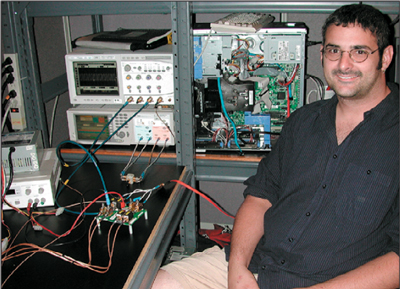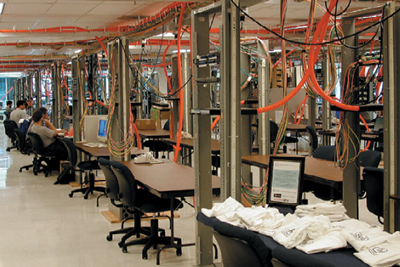Real World Training

Hands on at the Switzerland of the networking industry.
"We are the Switzerland of the networking industry," says Andy Baldman, member of the Senior Technical Staff at the Inter-Operability Lab at the University of New Hampshire (www.iol.unh.edu).
Established in 1988, the lab operates as a non-profit, independent and transparent test service. Its portfolio of tests spans all the important IEEE 802.x communications specs.
The InterOperability Lab is the largest and most extensive independent testing lab for the high-speed networking industry. There, the focus is on 20 different network technologies or "consortia," encompassing wire-line, wireless and optical fiber ranging from 10baseT to 10 Gbit Ethernet and protocols like DSL, SAS, SATA and IPv6.
With tight connections into the IEEE committees that create the specs, the UNH-IOL staff is expert at interpreting the specs and creating compliance tests based on them. In addition, since virtually all leading providers of network products are their clients, they have examples of all the popular last generation, current generation and some of the next generation network products. These are available to test interoperability with other products. Over the years, some tests have required the creation of specialized testing tools. To evaluate fast Ethernet systems (operating at 125 Mbps) testers needed to be able to re-create the whole range of signal quality from best to worst case attenuation and distortion, for cables 1 m to 100 m long. The bit stream signal after passing through these cables is the input to test the receiver quality of attached devices (FIGURE 1).
|
Instead of sifting through hundreds of cables in order to keep the best and worst ones around as golden standards, lab workers emulated the cable performance in MatLab code. By modeling the delays, distortions and losses of a cable with a few parameters, they were able to synthesize the transfer function for any arbitrary cable. A precision distorted 125 Mbps bit pattern is then turned into a real voltage signal with fast arbitrary function generator and fed into the network device under test.
Like many of the labs’ tests, the details of the procedure, and even the software, are available so members can duplicate every test at their own facilities. Member companies send their product designers to the lab to perform real time product development.
"We are more than a test house," Baldman said. "Our mission is to help the industry and train the next generation of engineers. We often have the designer testing their product in our lab during the day and re-writing the code at night to spin multiple designs in a week."
|
For an annual fee, a company can join one of the specific network protocol consortia and have access to extensive compliance testing, the valued UNH test report and an invitation to participate in "plugfests." A plugfest is a free for all "party" here 10 to 50 companies get together in one room and test out the compatibility of their network products with the other participating companies. Of the 32,000 feet2 of total lab space, the UNH-IOL allocates 7,500 feet2 to a group test period lab with identical setups of optical and wired cables to each station. It is neutral territory for competitors to evaluate the compatibility and interoperability of their specific products with a wide variety of network hardware and software.
Perhaps the most valuable function of the UNH-IOL, and what makes it unique, is the number of students involved in the testing. According to Kristin Harris, Customer Relations and Marketing manager, there are more than 100 undergraduate students and 20 graduate students working on staff in the lab. Over the 18-year history of the lab, more than 600 students have graduated with hands on, practical experience. "We provide practical applications and real world experience to all of our students," Harris said. And this real world experience has high value to the students. According to Harris, the placement rate for their students in industry jobs upon graduation is 95%-100%. With a base of 157 member companies, the UNH-IOL has established a solid technical reputation and willingly shares their expertise with the current generation of network engineers engineers, contributing to a significant fraction of the next generation of network aware engineers.
Dr. Eric Bogatin is president of Bogatin Enterprises. He can be reached at This email address is being protected from spambots. You need JavaScript enabled to view it..






